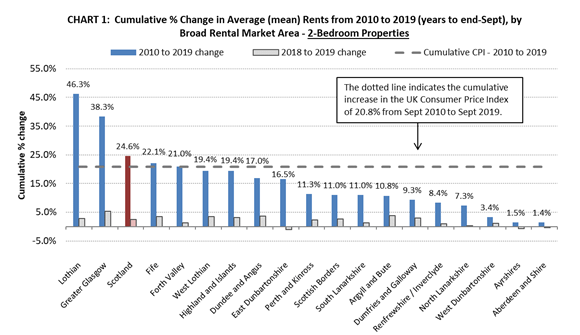Average 2 bedroom private rents up by 2.4%
An Official Statistics Publication for Scotland.
Between 2018 and 2019, 15 out of 18 Broad Rental Market Areas of Scotland have seen increases in average new let rents for 2 bedroom properties, ranging from 0.2% in North Lanarkshire, up to 5.3% in Greater Glasgow. Three areas have seen decreases, including Aberdeen and Shire which has seen a decrease of 0.3%, the fifth consecutive annual decrease, following decreased demand for rental properties in recent years due to the downturn in the oil industry. The Ayrshires also saw a decrease in the latest year of 0.7%, and East Dunbartonshire showed a decrease of 1.0%.
These regional trends combine to show an increase of 2.4% in average new let rents for 2 bedroom properties from £652 in 2018 to £668 in 2019. This compares to an increase in the UK Consumer Price Index of 1.7% in the year to Sept-19.
Over the longer term, across the period 2010 to 2019, average new let rents for 2 bedroom properties in Lothian, Greater Glasgow, Fife and Forth Valley have risen faster than the UK Consumer Price Index of 20.8% from Sept-10 to Sept-19 . Across this period, changes in average rents for 2 bedroom properties in other areas of the country have been below the rise in the consumer price index.
Statistics on private sector rent levels from 2010 to 2019 have been released today by Scotland’s Chief Statistician. The following main findings are based on 2 bedroom properties because these are the most prevalent size of property in the private rented sector. Figures on average rents across all property size categories, i.e. for 1, 2, 3, and 4 bedroom properties as well as 1 bedroom shared properties, are available in the main publication.
Note in the main findings below that the underlying market evidence data used to collate the publication figures is largely based on advertised rents, therefore it is important to note that the statistics presented do not represent rent increases for existing tenants.
Over the 9 year period from 2010 to 2019, the Lothian area of the country has seen the highest increase in private rents for 2 bedroom properties, with average monthly rents rising from £665 per month to £972, or 46.3% (cumulative increase over 9 years). Average rents in the Greater Glasgow area have risen by a cumulative 38.3% over the last 9 years (from £564 to £780).
For the remaining areas of Scotland, cumulative increases over the last 9 years have ranged from 1.4% in Aberdeen and Shire to 22.1% in Fife. These regional trends combine to show a 24.6% cumulative increase in average rents from 2010 to 2019 for 2 bedroom properties at the Scotland level, from £536 to £668.
For the year to end-September 2019, Lothian had the highest average monthly rents for 2 bedroom properties across Scotland (£972). Other areas with higher than average (£668) rents included Greater Glasgow (£780) and East Dunbartonshire (£677). Areas with the lowest average rents for 2 bedroom properties were and the Scottish Borders (£490), North Lanarkshire (£488), Dumfries and Galloway (£476) and The Ayrshires (£471).
Figures on changes to rents over the period from 2010 to 2019 should be considered in the context of the cumulative increase in the UK Consumer Price Index of 20.8% from Sept-10 to Sept-19.
Background
The figures released today were produced in accordance with professional standards set out in the Code of Practice for Official Statistics.
Read the full statistical publication.
This includes main findings on rent levels for 1 bedroom, 2 bedroom, 3 bedroom, 4 bedroom, and 1 bedroom shared properties. It presents information on rent levels for these different property sizes across each of the 18 broad rental market areas in Scotland and contains information on average rents as well as rents at the higher and lower end of the market.
The publication uses data from the Rent Service Scotland market evidence database, which is collected for the purposes of determining annual Local Housing Allowance levels and Local Reference Rent. The rental information contained in the market evidence database is largely based on advertised rents, therefore it is important to note that the statistics presented in this publication do not represent rent increases for existing tenants.
The aim of this statistical publication is to provide a detailed and user friendly presentation of private rental values, trends and distributions. The main users of this publication include those involved in housing policy and practice, researchers, tenants, landlords, letting agents, and other individuals with an interest in the private rented sector.
Official statistics are produced in accordance with professional standards – read more information on the standards of official statistics in Scotland.
There is a problem
Thanks for your feedback
